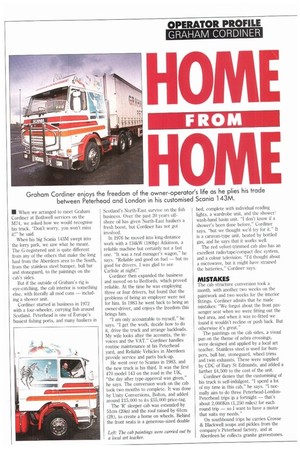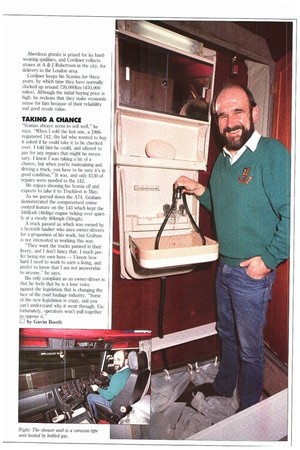HOME
Page 52

Page 53

If you've noticed an error in this article please click here to report it so we can fix it.
FROM
HOME
When we arranged to meet Graham Cordiner at Bothwell services on the M74, we asked how we would recognise his truck. "Don't worry, you won't miss it!" he said.
When his big Scalia 143M swept into the lorry park, we saw what he meant. The G-registered unit is quite different from any of the others that make the long haul from the Aberdeen area to the South, from the stainless steel bumper, bull bar and stoneguard, to the paintings on the cab's sides.
But if the outside of Graham's rig is eye-catching, the cab interior is something else, with literally all mod cons — including a shower unit.
Cordiner started in business in 1972 with a four-wheeler, carrying fish around Scotland. Peterhead is one of Europe's busiest fishing ports, and many hauliers in Scotland's North-East survive on the fish business. Over the past 20 years offshore oil has given North-East hauliers a fresh boost, but Cordiner has not got involved.
In 1976 he moved into long-distance work with a 134kW (180hp) Atkinson, a reliable machine but certainly not a fast one. "It was a real manager's wagon," he says. "Reliable and good on fuel — but no good for drivers. I was glad to see Carlisle at night!"
Cordiner then expanded the business and moved on to Bedfords, which proved reliable. At the time he was employing three or four drivers, but found that the problems of being an employer were not for him. In 1983 he went back to being an owner-driver, and enjoys the freedom this brings him.
"I am only accountable to myself," he says. "I get the work, decide how to do it, drive the truck and arrange backloads. My wife looks after the accounts, the invoices and the VAT." Cordiner handles routine maintenance at his Peterhead yard, and Reliable Vehicles in Aberdeen provide service and parts back-up.
He went over to Scanias in 1983, and the new truck is his third. It was the first 470 model 143 on the road in the UK, "the day after type-approval was given," he says. The conversion work on the cab took two months to complete. It was done by Unity Conversions, Bolton, and added around 215,000 to its 255,000 price-tag.
The 'R' sleeper cab was extended by 51cm (20in) and the roof raised by 61cm (2ft), to create a home on wheels. Behind the front seats is a generous-sized double bed, complete with individual reading lights, a wardrobe unit, and the shower/ wash-hand basin unit. "I don't know if a shower's been done before," Cordiner says, "but we thought we'd try for it." It is a caravan-type unit, heated by bottled gas, and he says that it works well.
The red velvet-trimmed cab also has an excellent radio/tape/compact disc system, and a colour television. "I'd thought about a microwave, but it might have strained the batteries," Cordiner says.
MISTAKES
The cab structure conversion took a month, with another two weeks on the paintwork and two weeks for the interior fittings. Cordiner admits that he made mistakes: "We forgot about the front passenger seat when we were fitting out the bed area, and when it was re-fitted we found it wouldn't recline or push back. But otherwise it's great."
The paintings on the cab sides, a visual pun on the theme of zebra crossings, were designed and applied by a local art teacher. Stainless steel is used for bumpers, bull bar, stoneguard, wheel trims and twin exhausts. These were supplied by CDC of Bury St Edmunds, and added a further 24,500 to the cost of the unit.
Cordiner denies that the customising of his truck is self-indulgent. "I spend a lot of my time in this cab," he says. "I normally aim to do three Peterhead-LondonPeterhead trips in a fortnight — that's about 2,000Km (1,250 miles) for each round trip — so I want to have a motor that suits my needs."
On southbound trips he carries Crosse & Blackwell soups and pickles from the company's Peterhead factory, and at Aberdeen he collects granite gravestones. Aberdeen granite is prized for its hardwearing qualities, and Cordiner collects stones at A & J Robertson in the city, for delivery in the London area.
Cordiner keeps his Scanias for three years, by which time they have normally clocked up around 720,000km (450,000 miles). Although the initial buying price is high, he reckons that they make economic sense for him because of their reliability and good resale value.
TAKING A CHANCE
-Scanias always seem to sell well," he says. "When I sold the last one, a 1986registered 142, the lad who wanted to buy it asked if he could take it to be checked over. I told him he could, and offered to pay for any repairs that might be necessary. I knew I was taking a bit of a chance, but when you're maintaining and driving a truck, you have to be sure it's in good condition." It was, and only £130 of repairs were needed to the 142.
He enjoys showing his Scania off and expects to take it to Truckfest in May.
As we purred down the A74, Graham demonstrated the computerised cruise control feature on the 143 which kept the 346Kwh (464hp) engine ticking over quietly at a steady 80kmph (50mph).
A truck passed us which was owned by a Scottish haulier who uses owner-drivers for a proportion of his work, but Graham is not interested in working this way.
"They want the trucks painted in their livery, and I don't fancy that. I much prefer being my own boss — I know how hard I need to work to earn a living, and prefer to know that I am not answerable to anyone," he says.
His only complaint as an owner-driver is that he feels that he is a lone voice against the legislation that is changing the face of the road haulage industry. "Some of the new legislation is crazy, and you can't understand why it went through. Unfortunately, operators won't pull together to oppose it." 0 by Gavin Booth














































































































